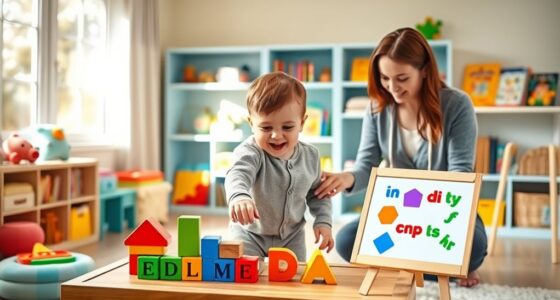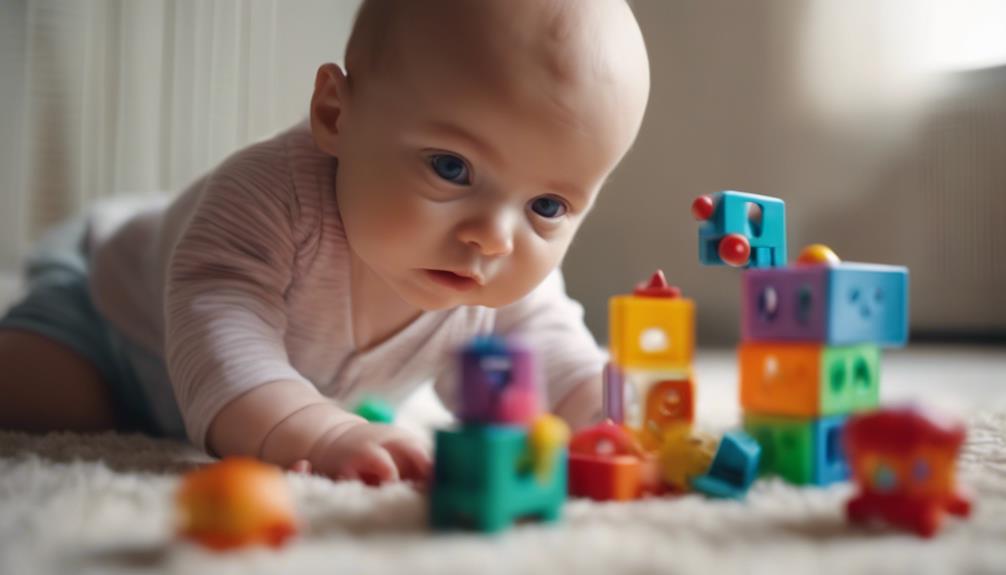To encourage curiosity and foster a love of learning in toddlers, create a stimulating environment filled with sensory-rich activities, themed discovery zones, and natural materials. Prompt their questions and model enthusiastic exploration to inspire active inquiry. Use engaging books and storytelling alongside hands-on experiences like sensory bins and outdoor adventures. Support independence, celebrate effort, and encourage social interactions. Keep nurturing their natural curiosity, and you’ll find ways to make learning joyful and fulfilling. Keep exploring these ideas to see how you can grow their love for discovery.
Key Takeaways
- Create sensory-rich environments with textures, colors, and smells to spark exploration and stimulate curiosity.
- Use open-ended questions and model inquisitive behavior to encourage active inquiry and critical thinking.
- Incorporate hands-on, play-based activities like outdoor adventures and sensory bins to foster tactile learning.
- Celebrate effort and discoveries to build confidence and motivate ongoing exploration.
- Engage children with storytelling, visual aids, and themed zones to nurture imagination and a love for learning.
Providing a Stimulating Environment for Exploration

Creating a stimulating environment encourages toddlers to explore and learn naturally. You can design sensory gardens filled with textures, colors, and smells to engage their senses and foster curiosity. These gardens provide a safe space where children can touch different plants, listen to natural sounds, and observe various textures. Additionally, themed discovery zones can spark their imagination and promote hands-on exploration. For example, a mini farm or ocean-themed area invites them to investigate objects closely, encouraging curiosity about the world around them. By offering these engaging setups, you create an environment that invites toddlers to investigate, discover, and learn at their own pace. Incorporating self-watering plant pots into these spaces can also serve as an educational tool, demonstrating how plants receive water and grow, further stimulating their curiosity about nature and living things. Understanding the importance of visual stimuli can help you choose the most engaging and age-appropriate materials for your child’s exploration. Providing a variety of sensory experiences can enhance their learning and curiosity even more. Engaging children with hands-on activities supports their cognitive development and nurtures their innate desire to explore and understand their surroundings. Additionally, providing opportunities for children to interact with natural materials can deepen their understanding of the environment and promote sustainable awareness. This foundation of sensory-rich and themed spaces nurtures their innate desire to explore and understand their surroundings.
Incorporating Play-Based Learning Activities
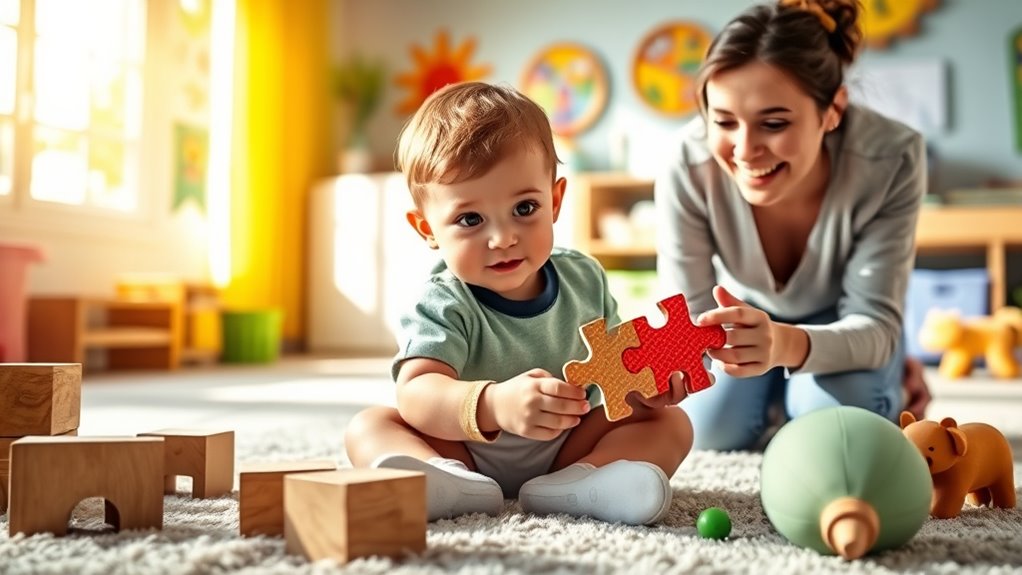
Incorporating play-based learning activities into your daily routine transforms exploration into engaging experiences that promote curiosity and development. Take your toddler on outdoor adventures, where they can discover nature’s wonders firsthand—collecting leaves, observing insects, or climbing safely. These activities stimulate their senses and spark curiosity about the world around them. Additionally, encourage artistic expression through simple activities like finger painting, drawing, or crafting with natural materials. These creative outlets help your child explore textures, colors, and shapes, fostering their imagination. Using safe and engaging toys can further enhance sensory development and curiosity during play. Incorporating diverse learning opportunities into daily routines ensures that curiosity becomes a natural part of your child’s growth. Exploring educational technology responsibly can also support personalized learning and engagement. Including portable camping gear like tents or outdoor equipment can inspire outdoor exploration and curiosity, connecting learning with real-world experiences. Engaging children with developmentally appropriate activities helps nurture their innate desire to learn and discover. Play-based learning makes curiosity a natural part of daily life, blending outdoor exploration with artistic pursuits. By integrating these activities, you create a rich environment that nurtures your toddler’s love of learning through fun and meaningful experiences.
Encouraging Questions and Active Inquiry

How can you encourage your toddler to become an active questioner and curious learner? Start by using question prompts that invite exploration, like “What do you think will happen if…?” or “Why do you think that is?” These questions spark curiosity sparks and motivate your child to investigate further. Respond enthusiastically to their questions, showing that their curiosity is valued. Avoid dismissing their inquiries; instead, guide them to discover answers through play, observation, or simple experiments. By fostering an environment where questions are welcomed, you promote active inquiry and critical thinking. Remember, your reactions shape their attitude toward learning, making curiosity a natural and joyful part of their everyday experiences. Recognizing that prophetic dreams often involve symbols and personal insights can also inspire children to interpret and explore their own thoughts and feelings in a meaningful way. Cultivating a learning mindset from a young age encourages ongoing curiosity and resilience in the face of challenges. Developing an understanding of educational concepts can further support their intellectual growth. Additionally, emphasizing the importance of positive reinforcement can motivate children to continue exploring and asking questions. Creating opportunities for children to engage with their environment further enhances their desire to learn and discover new things.
Using Books and Storytelling to Spark Imagination
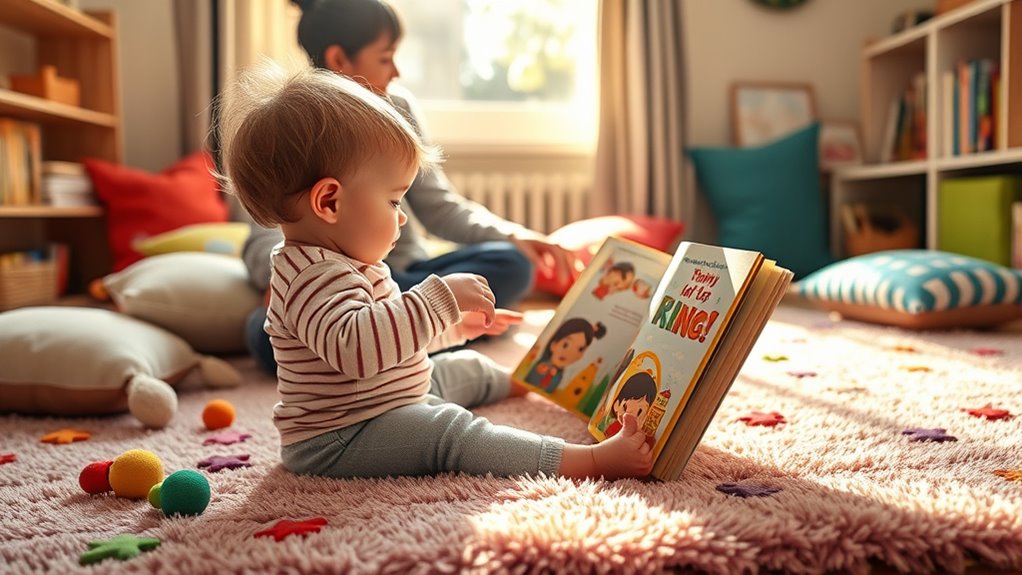
Choosing engaging stories and using interactive reading techniques can turn storytime into a magical experience. When you ask questions or encourage your toddler to relate parts of the story, you inspire their imagination. These methods make reading a lively activity that sparks curiosity and exploration.
Choosing Engaging Stories
What makes a story truly engaging for a toddler? It starts with thoughtful story selection. Look for books with vibrant illustrations, simple language, and themes that spark curiosity. The narrative structure is equally important—stories with a clear beginning, middle, and end help toddlers follow along and build understanding. Choose stories that introduce relatable characters and situations, encouraging your child to connect and imagine. Avoid overly complex plots or long-winded sentences that might cause frustration. Instead, opt for stories that invite participation and curiosity. When you select books with engaging narratives, you’re not just entertaining—you’re nurturing their love for learning and sparking their imagination. A well-chosen story becomes a gateway to discovery and a foundation for lifelong curiosity.
Interactive Reading Techniques
Engaging your toddler during storytime goes beyond simply reading aloud; it involves actively involving them in the storytelling process. Use dialogue techniques to make characters come alive, encouraging your child to repeat phrases or imagine different voices. Incorporate questioning strategies to spark curiosity and deepen understanding—ask open-ended questions like, “What do you think happens next?” or “How would you feel if you were that character?” These prompts invite your toddler to think creatively and share their ideas. Pause frequently to discuss the story, making eye contact and responding to their observations. This interactive approach transforms reading into an engaging activity that nurtures their imagination and love of learning, helping them see books as exciting adventures rather than passive experiences. Additionally, bringing elements of essential oils for imagination into the environment, such as diffusing gentle scents like lavender or ylang-ylang, can create a calming and stimulating atmosphere that encourages curiosity and focus during storytime. Incorporating visual aids and props can also enhance their understanding and make the storytelling more dynamic and memorable. Furthermore, introducing Glycolic Acid benefits for skin concepts gently through stories about skin or self-care can subtly expand their vocabulary and curiosity about health and science. Exploring sound healing science concepts in a simple way, like describing how soothing sounds can help us feel better, can also enrich their understanding of sensory experiences.
Offering Hands-On Experiences and Sensory Play
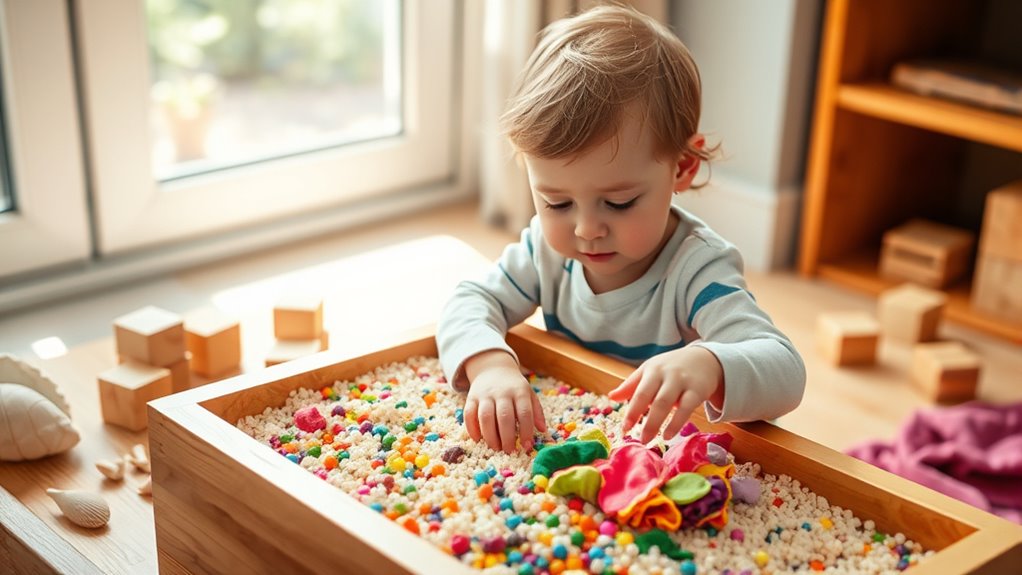
Offering hands-on experiences and sensory play allows toddlers to explore their environment actively and develop their curiosity naturally. Sensory bins provide a safe space for texture exploration, engaging their senses and encouraging discovery. These activities help children learn through direct interaction, fostering problem-solving skills and independence. You can introduce materials like rice, beans, or water to create diverse tactile experiences. Incorporating different textures keeps their interest high and promotes curiosity. Use the following table to inspire ideas:
| Sensory Material | Texture Exploration | Activity Ideas |
|---|---|---|
| Rice | Soft, gritty | Fill and pour |
| Water | Wet, slippery | Splash and scoop |
| Beans | Firm, smooth | Sorting and pouring |
| Sand | Grainy, dry | Building and digging |
| Playdough | Moldable, squishy | Sculpting and squeezing |
Engaging in these activities also supports digital literacy, as children become familiar with various tools and materials in their environment. Developing sensory processing skills through these activities can also improve their overall cognitive development, fostering curiosity and a love for learning. Additionally, incorporating structured play can enhance their ability to focus and follow simple instructions, further supporting their growth.
Modeling Curious Behavior and Lifelong Learning
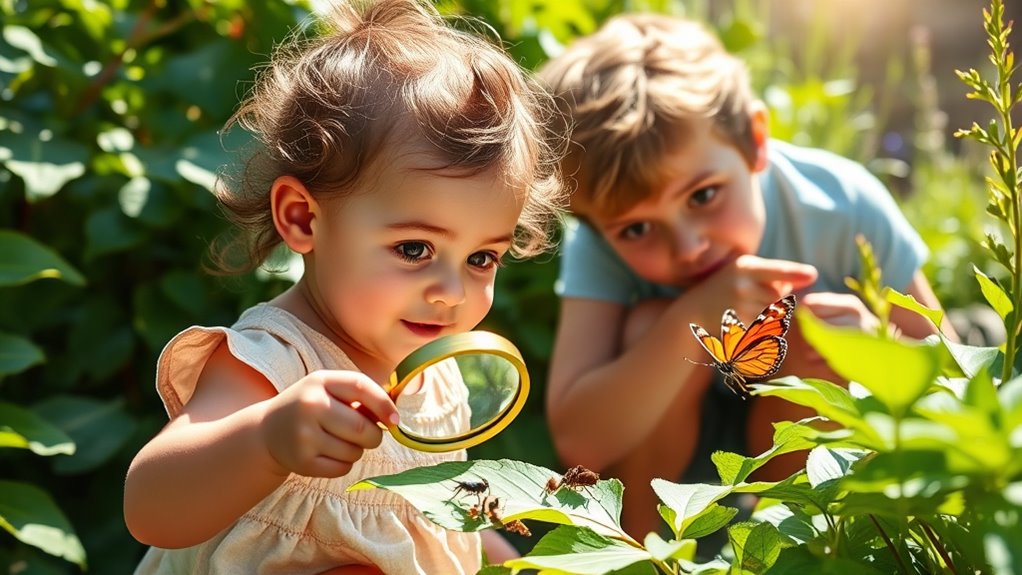
Modeling curious behavior in toddlers sets a powerful example that sparks their natural desire to learn. Your role modeling shows them how to explore and ask questions, demonstrating that learning is an ongoing, enjoyable process. When you openly express curiosity—like examining a bug or reading about new topics—you teach your child that curiosity is valuable. This consistent display of lifelong learning encourages them to adopt similar habits, seeing you as a model for discovery and growth. By demonstrating enthusiasm for learning and embracing new experiences, you foster a mindset that values exploration. Your actions inspire your toddler to develop their own curiosity and view learning as an exciting part of everyday life, laying the foundation for a lifelong love of discovery.
Celebrating Effort and Discovery

Celebrating your toddler’s efforts and discoveries reinforces their motivation to explore and learn. When you acknowledge effort recognition, you show them that trying hard matters, regardless of the outcome. This boosts their confidence and encourages further exploration. Discovery celebration involves praising their curiosity and highlighting new things they’ve uncovered. For example, if they figure out how to stack blocks or identify a new animal, cheer them on enthusiastically. Your positive reactions make learning enjoyable and meaningful, fostering an intrinsic love for discovery. Remember, it’s not just about the success but also about valuing their process and persistence. By consistently recognizing effort and celebrating discoveries, you help your toddler develop resilience and a genuine enthusiasm for learning that can last a lifetime.
Creating Opportunities for Social Interaction
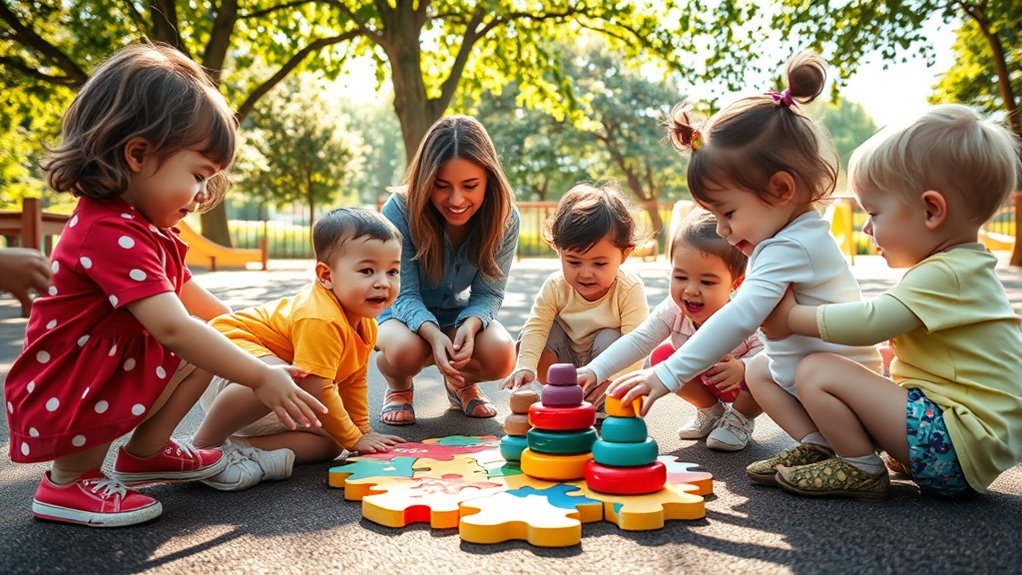
You can help your toddler build peer connections by arranging play dates and group activities. These interactions encourage curiosity as they explore social cues and shared interests. Creating regular opportunities for social play fosters your child’s desire to learn and connect with others.
Building Peer Connections
Creating opportunities for social interaction is essential for helping toddlers build peer connections. When you facilitate chances for toddlers to engage with their peer group, they develop social bonding and learn important communication skills. These interactions help them understand sharing, empathy, and cooperation. You can create a vivid picture with this table:
| Engaging Activity | Environment |
|---|---|
| Playgroup | Playground |
| Storytime | Library |
| Art Class | Community Center |
Imagine toddlers laughing during playgroup, exchanging smiles, and exploring new ideas together. These moments strengthen their peer group bonds and foster curiosity through social engagement. By encouraging regular social interactions, you support their emotional growth and nurture a love of learning through meaningful peer connections.
Encouraging Play Dates
Encouraging play dates offers toddlers valuable opportunities to develop social skills in a relaxed setting. These interactions help your child learn to build trust with peers, which is essential for healthy relationships. During play dates, children practice sharing, taking turns, and communicating their needs. As conflicts arise, your role is to guide them in managing disagreements calmly, helping them understand different perspectives. By modeling patience and empathy, you teach your toddler how to resolve conflicts constructively. Creating a safe, supportive environment encourages your child to explore new social dynamics and fosters curiosity about others. Regular play dates also boost confidence as your toddler experiences successful social interactions, reinforcing their love of learning and discovery through meaningful peer connections.
Supporting Independence and Decision-Making Skills

Supporting independence and decision-making skills in toddlers lays the foundation for their confidence and problem-solving abilities. You can encourage independent decision-making by offering your child opportunities to make self-directed choices daily. For example, let them pick between two outfits or choose a snack from a small selection. This process helps your toddler develop their confidence in making decisions and fosters a sense of control. Avoid over-directing; instead, guide them gently and praise their efforts. As they practice selecting activities or items, they learn to trust their judgment. Supporting these self-directed choices not only nurtures curiosity but also builds essential skills for future independence. Remember, patience and encouragement are key to helping your child thrive in their decision-making journey.
Frequently Asked Questions
How Can Parents Balance Guiding Curiosity Without Overwhelming Toddlers?
Balancing guidance and managing overstimulation is key when supporting your toddler’s curiosity. You should observe their interests and gently encourage exploration without pushing too hard. Create a calm environment, set limits on new activities, and offer frequent breaks to prevent overwhelm. By staying attentive to your child’s cues and providing age-appropriate opportunities, you help nurture their love of learning while keeping their experience positive and manageable.
What Are Simple Ways to Integrate Curiosity Into Daily Routines?
You can easily integrate curiosity into daily routines by engaging in sensory play, which stimulates your toddler’s senses and encourages exploration. Ask open-ended questions like, “What do you think this feels like?” or “What happens when you pour water?” These activities make learning fun and natural, helping your toddler develop a love for discovery while you bond and nurture their growing curiosity every day.
How Does Curiosity Impact Long-Term Academic Success?
Curiosity plays a crucial role in your child’s long-term academic success by stimulating brain development and boosting motivation. When they explore and ask questions, their brains form stronger connections, making learning easier and more engaging. Encouraging curiosity keeps your child motivated to discover new things, fostering a love for learning that can lead to better problem-solving skills and academic achievement in the future.
Are There Specific Toys That Best Promote Curiosity?
Think of toys as keys to a treasure chest of curiosity. Interactive puzzles and open-ended toys unfasten your toddler’s imagination, encouraging exploration. I once watched my child invent stories with simple blocks, turning play into discovery. Studies show these toys boost problem-solving and creativity. So, choose toys that invite questions and experimentation, helping your little one develop a love of learning that lasts a lifetime.
How Can Caregivers Handle Safety Concerns During Exploration?
When managing safety during your toddler’s exploration, focus on supervision strategies that keep them protected without stifling curiosity. Stay close and engaged, constantly observing for hazard identification, like sharp edges or choking hazards. Create a safe environment by removing dangerous objects and using safety gates. Encourage exploration in designated safe areas, and teach your toddler about boundaries. Your active involvement guarantees they learn and discover safely, fostering their love for learning.
Conclusion
Fostering curiosity in your toddler sets the foundation for lifelong learning. By providing a stimulating environment, encouraging questions, and modeling inquisitiveness, you nurture their natural desire to explore. Did you know that early curiosity is linked to better problem-solving skills later in life? Keep celebrating discoveries and supporting independence. Your active engagement sparks a love of learning that can last a lifetime, shaping your child’s confidence and enthusiasm for the world around them.




